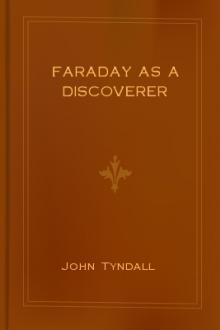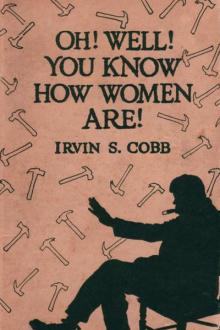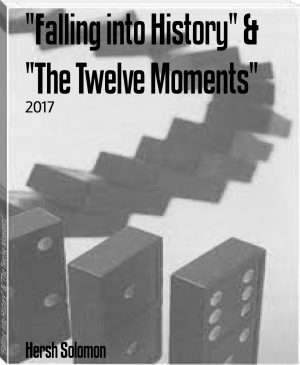The Chemical History of a Candle by Michael Faraday (detective books to read TXT) 📕

- Author: Michael Faraday
- Performer: -
Book online «The Chemical History of a Candle by Michael Faraday (detective books to read TXT) 📕». Author Michael Faraday
I see you are not tired of the candle yet, or I am sure you would not be interested in the subject in the way you are. When our candle was burning, we found it produced water exactly like the water we have around us; and by further examination of this water we found in it that curious body, hydrogen—that light substance of which there is some in this jar. We afterwards saw the burning powers of that hydrogen, and that it produced water. And I think I introduced to your notice an apparatus which I very briefly said was an arrangement of chemical force, or power, or energy, so adjusted as to convey its power to us in these wires; and I said I should use that force to pull the water to pieces, to see what else there was in the water besides hydrogen; because, you remember, when we passed the water through the iron tube, we by no means got the weight of water back which we put in, in the form of steam, though we had a very large quantity of gas evolved. We have now to see what is the other substance present. That you may understand the character and use of this instrument, let us make an experiment or two. Let us put together, first of all, some substances, knowing what they are, and then see what that instrument does to them. There is some copper (observe the various changes which it can undergo), and here is some nitric acid, and you will find that this, being a strong chemical agent, will act very powerfully when I add it to the copper. It is now sending forth a beautiful red vapour; but as we do not want that vapour, Mr. Anderson will hold it near the chimney for a short time, that we may have the use and beauty of the experiment without the annoyance. The copper which I have put into the flask will dissolve: it will change the acid and the water into a blue fluid, containing copper and other things; and I propose then shewing you how this voltaic battery deals with it; and in the mean-time we will arrange another kind of experiment for you to see what power it has. This is a substance which is to us like water—that is to say, it contains bodies which we do not know of as yet, as water contains a body which we do not know as yet. Now, this solution of a salt[15] I will put upon paper, and spread about, and apply the power of the battery to it, and observe what will happen. Three or four important things will happen which we shall take advantage of. I place this wetted paper upon a sheet of tinfoil, which is convenient for keeping all clean, and also for the advantageous application of the power; and this solution, you see, is not at all affected by being put upon the paper or tinfoil, nor by anything else I have brought in contact with it yet, and which, therefore, is free to us to use as regards that instrument. But first let us see that our instrument is in order. Here are our wires. Let us see whether it is in the state in which it was last time. We can soon tell. As yet, when I bring them together, we have no power, because the conveyers—what we call the electrodes—the passages or ways for the electricity—are stopped; but now Mr. Anderson by that [referring to a sudden flash at the ends of the wires] has given me a telegram to say that it is ready. Before I begin our experiment I will get Mr. Anderson to break contact again at the battery behind me, and we will put a platinum-wire across to connect the poles, and then if I find I can ignite a pretty good length of this wire, we shall be safe in our experiment. Now you will see the power. [The connection was established, and the intermediate wire became red-hot.] There is the power running beautifully through the wire, which I have made thin on purpose to shew you that we have those powerful forces; and now, having that power, we will proceed with it to the examination of water.
I have here two pieces of platinum, and if I lay them down upon this piece of paper [the moistened paper on the tinfoil], you will see no action; and if I take them up, there is no change that you can see, but the arrangement remains just as it was before. But, now, see what happens: if I take these two poles and put either one or the other of them down separately on the platinum-plates, they do nothing for me, both are perfectly without action; but if I let them both be in contact at the same moment, see what happens [a brown spot appeared under each pole of the battery]. Look here at the effect that takes place, and see how I have pulled something apart from the white—something brown; and I have no doubt, if I were to arrange it thus, and were to put one of the poles to the tinfoil on the other side of the paper—why, I get such a beautiful action upon the paper, that I am going to see whether I cannot write with it—a telegram, if you please. [The Lecturer here traced the word "juvenile" on the paper with one of the terminal wires.] See there how beautifully we can get our results!
You see we have here drawn something, which we have not known about before, out of this solution. Let us now take that flask from Mr. Andersen's hands, and see what we can draw out of that. This, you know, is a liquid which we have just made up from copper and nitric acid, whilst our other experiments were in hand; and though I am making this experiment very hastily, and may bungle a little, yet I prefer to let you see what I do rather than prepare it beforehand.
Now, see what happens. These two platinum-plates are the two ends (or I will make them so immediately) of this apparatus; and I am about to put them in contact with that solution just as we did a moment ago on the paper. It does not matter to us whether the solution be on the paper or whether it be in the jar, so long as we bring the ends of the apparatus to it. If I put the two platinums in by themselves, they come out as clean and as white as they go in [inserting them into the fluid without connecting them with the battery]; but when we take the power and lay that on [the platinums were connected with the battery and again dipped into the solution], this, you see [exhibiting one of the platinums], is at once turned into copper, as it were: it has become like a plate of copper; and that [exhibiting the other piece of platinum] has come out quite clean. If I take this coppered piece and change sides, the copper will leave the right-hand side and come over to the left side; what was before the coppered plate comes out clean, and the plate which was clean comes out coated with copper; and thus you see that the same copper we put into this solution we can also take out of it by means of this instrument.
Putting that solution aside, let us now see what effect this instrument will have upon water. Here are two little platinum-plates which I intend to make the ends of the battery, and this (C) is a little vessel so shaped as to enable me to take it to pieces, and shew you its construction. In these two cups (A and B) I pour mercury, which touches the ends of the wires connected with the platinum-plates. In the vessel (C) I pour some water containing a little acid (but which is put only for the purpose of facilitating the action; it undergoes no change in the process), and connected with the top of the vessel is a bent glass tube (D), which may remind you of the pipe which was connected with the gun barrel in our furnace experiment, and which now passes under the jar (F). I have now adjusted this apparatus, and we will proceed to affect the water in some way or other. In the other case, I sent the water through a tube which was made red-hot; I am now going to pass the electricity through the contents of this vessel. Perhaps I may boil the water; if I do boil the water, I shall get steam; and you know that steam condenses when it gets cold, and you will therefore see by that whether I do boil the water or not. Perhaps, however, I shall not boil the water, but produce some other effect. You shall have the experiment and see. There is one wire which I will put to this side (A), and here is the other wire which I will put to the other side (B), and you will soon see whether any disturbance takes place. Here it is seeming to boil up famously; but does it boil? Let us see whether that which goes out is steam or not. I think you will soon see the jar (F) will be filled with vapour, if that which rises from the water is steam. But can it be steam? Why, certainly not; because there it remains, you see, unchanged. There it is standing over the water, and it cannot therefore be steam, but must be a permanent gas of some sort What is it? Is it hydrogen? Is it anything else? Well, we will examine it. If it is hydrogen, it will burn. [The Lecturer then ignited a portion of the gas collected, which burnt with an explosion.]
[Illustration: Fig. 19]
It is certainly something combustible, but not combustible in the way that hydrogen is. Hydrogen would not have given you that noise; but the colour of that light, when the thing did burn, was like that of hydrogen: it will, however, burn without contact with the air. That is why I have chosen this other form of apparatus, for the purpose of pointing out to you what are the particular circumstances of this experiment. In place of an open vessel I have taken one that is closed (our battery is so beautifully active that we are even boiling the mercury, and getting all things right—not wrong, but vigorously right); and I am going to shew you that that gas, whatever it may be, can burn without air, and in that respect differs from a candle, which cannot burn without the air. And our manner of doing this is as follows:—I have here a glass vessel (G) which is fitted with two platinum-wires (IK), through which I can apply electricity; and we can put the vessel on the air-pump and exhaust the air, and when we have taken the air out we can bring it here and fasten it on to this jar (F), and let into the vessel that gas which was formed by the action of the voltaic battery upon the water, and which we have produced by changing the water into it,—for I may go as far as this, and say we have really, by that experiment, changed the water into that gas. We have not only altered its condition, but we have changed it really and truly into that gaseous substance, and all the water is there which was decomposed by the experiment. As I screw this vessel (GH) on here (H), and make the tubes well connected, and when I open the stop-cocks (HHH), if you watch the level of the water (in F), you will see that the gas will rise. I will now close the stop-cocks, as I have drawn up as much as the vessel can hold, and being safely conveyed into that chamber, I will pass into it an electric spark from this Leyden jar (L), when the vessel, which is now quite clear and bright, will become dim. There will be no sound, for the vessel is strong enough to confine the explosion. [A spark was then passed through the jar, when the explosive mixture was ignited.] Did you see that brilliant light? If I again screw the vessel on to the jar, and open these stop-cocks, you will see that the gas





Comments (0)